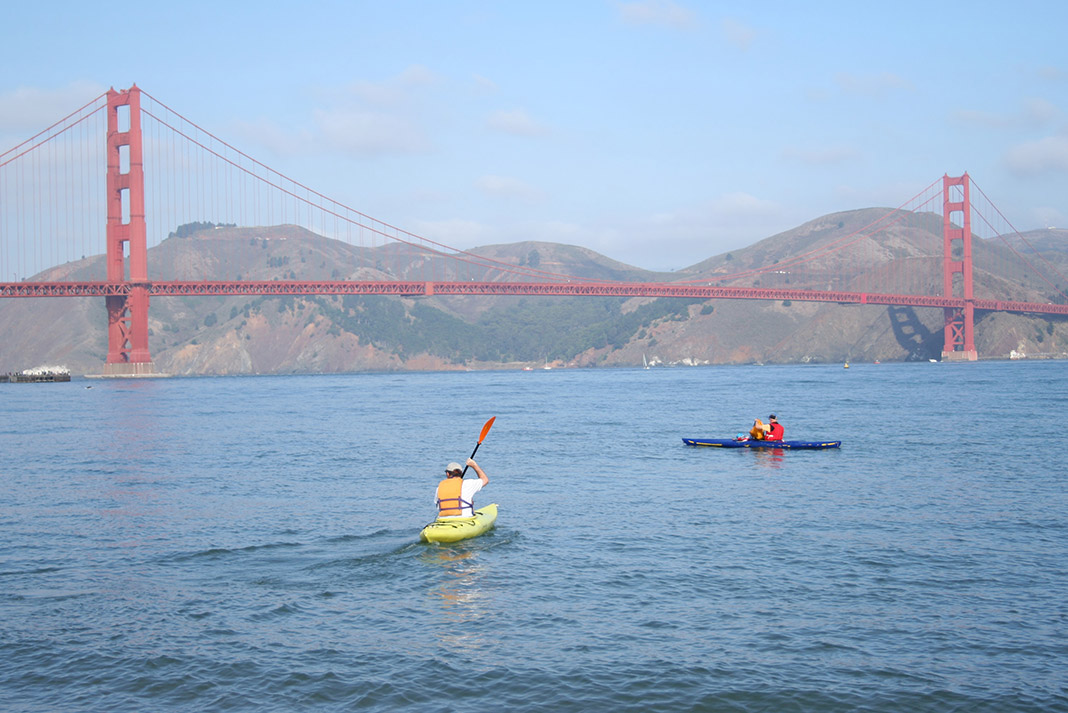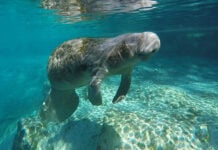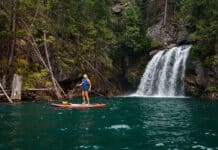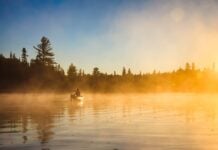San Francisco, California is a well-known city across the globe for many reasons: the Golden Gate Bridge, foggy summers, cable car rides up steep hillsides and unique architecture, to name a few. The City by the Bay also offers an interesting and varied coastal life. From calm rivers to rocky island skimming, peaceful wildlife sanctuaries to bustling wharves, San Francisco offers paddling opportunities to kayakers of all skill levels.

Kayak rentals in San Francisco
Being situated next to the ocean, kayak rental companies abound in the area. Here are a few of the top companies to check out.
City Kayak
City Kayak rents a variety of types of kayaks, including single and double open top and touring kayaks, polymer and carbon surfskis, and take away single and double inflatable kayaks (as well as roof racks). All of the above are priced by how many hours or days you plan on taking them out and range from $35 to $424.
Sea Trek
If you are planning a trip during the winter and don’t want to worry about limited business hours, Sea Trek may be the right rental company for you. They are open daily, excluding Mondays, from early December to March. You can find both single and double sit-on-top and sit-inside kayaks ranging from $25 to $45 per hour. These are one-hour minimums and fees are prorated on each additional 15 minutes.
California Canoe & Kayak
California Canoe & Kayak also offers hourly and take away rentals. Their hourly rentals range from $25 for a single to $50 for a double Hobie Mirage. One-day take away rentals of single sit-on-top kayaks start at $75 per day. Be sure to check out their plethora of classes as well, including kayak rolling and whitewater.
Kayak tours in San Francisco
With so many different sights to see in and out of the water, San Francisco offers an interesting range of guided kayak tours. Here are some of the best ones to check into, regardless of your skill level.
San Francisco Kayak & Adventures
SF Kayak offers a variety of sea-going adventures, including the popular Sausalito Waterfront, McCovey Cove, and Sunset/Moonlight paddles. Group tours range from $80 to $150 (not including private tour group rates). Note that all of their guided tours are held in tandem sit-inside kayaks to ensure the comfort and safety of participants. Solo sit-inside kayaks are only an option for those who have wet exit and re-entry certification in a traditional sit-in style kayak.
Half Moon Bay Kayak Co.
No matter what time of day you’re looking to take a guided tour, Half Moon Bay has you covered. Go for a morning paddle through Fitzgerald Marine Reserve ($160), spend the afternoon in Pillar Point Harbor ($95), or enjoy the calm waters of the harbor on a sunset paddle ($95). Bringing the family? They have the perfect trip for you too! After a short safety briefing and period of time getting accustomed to your boat, you and your family will explore the calm waters of a protected harbor and possibly check out some tide pools, depending on tidal conditions. This three-hour tour runs $95 per adult and $60 per child (under 14).
Blue Waters Kayaking
BWK offers an assortment of unique tours you won’t want to miss out on. These include a Tomales Bay morning paddle ($88), Birding by Kayak tour ($128), and even a Lake Sonoma Full Moon camping trip ($175). If you’re into night paddling, another fun tour to check out is their bioluminescence night paddle (prices range from $98 to $118 depending on the season)—you can enjoy the underwater light show as tiny, bioluminescent dinoflagellates flicker when disturbed and schools of fish create phosphorescent trails behind them.
Places to kayak near San Francisco
With roughly 1,600 square miles of bay to explore, it goes without saying that there is no shortage of places to kayak San Francisco. Let’s take a look at some of the must-see areas to explore by kayak.
The Golden Gate Bridge
No kayaking trip in San Francisco would be complete without venturing under the Golden Gate Bridge. Enjoy views of the Sausalito coastline as well as the Marin Headlands on your paddle out.
Elkhorn Slough
If you’re looking for something a little more laid-back and quiet, take a two-hour drive down the coast to Elkhorn Slough. This estuary offers calm waters—perfect for families with young kayakers—as well as wildlife viewing opportunities. Expect to find sea otters, seals and waterfowl aplenty.
Tomales Bay
If you’re not looking for full-on sea kayaking, Tomales Bay may be the place for you. This popular 15-mile-long inlet is located about 1.5 hours north of downtown SF. Be sure to visit the bay during the summer for the best chance to view the bioluminescent plankton.
Oakland Estuary
Close to the hustle and bustle of the main city, Oakland Estuary provides easy access to city dwellers for a quick trip on the water. Though you will initially view many of the restaurants along the waterfront, if you head about 10 minutes south you will find a much calmer area with more chances to view local marine life, such as bat rays, leopard sharks and seals.
McCovey Cove
Located a short 10 minutes from downtown San Francisco, McCovey Cove is also easy to access and a local favorite. In fact, Giants baseball fans have been known to kayak into the cove during games, hoping to catch a runaway home-run ball.
Russian River
More accustomed to river kayaking? No problem! A bit out of the way at two hours north of the city, the Russian River is a local favorite for river kayaking. Enjoy a relaxing day paddling the lazy waters, the quality of which makes it great for stopping for a swim or to cast a line out. Be sure to pack a picnic lunch to replenish your energy along the tree-lined shore.
Special considerations when kayaking in the Bay Area
Whether you are an experienced sea kayaker or have never seen the coast, keep the following in mind when planning a kayaking trip to the Bay Area:
- Some areas receive big tidal swings and strong currents. Check online or with locals before heading out on the water.
- It can become very windy in certain areas, especially in the early afternoon, so it’s important to pay attention to which way the wind is blowing from and take note of changes.
- Fog, which is particularly abundant during the summer months, can hinder bigger boats from seeing you, so use caution. The fog can also be very disorienting out on the water.
- Water temperature averages range from 52 to 61°F year-round. It may be prudent to wear a wet or drysuit. Always wear your PFD.
- BASK, or Bay Area Sea Kayakers, offers a list of off-limits areas.
Kayak fishing in San Francisco
Several types of fish can be caught regularly near San Francisco, including striped bass, sturgeon, halibut, salmon, rockfish, sharks (leopards are the most common) and sea trout (some people also enjoy crabbing in the area). Fishing near SF can be tricky as fish activity is based on tides. Naturally, each type of fish prefers certain areas at certain times of year.
Here is a general list of places to cast out according to fish species:
- Halibut: Crissy Field, Paradise Beach, Angel Island | Spring
- Sturgeon: San Pablo Bay, China Camp, Alameda | Winter
- Striped bass: Suisun Slough, Bakers Beach | Summer
- Salmon: Marin Coast, Dillons Beach | Fall
- Piers are said to be great places to find perch and rock crab
Safety considerations
In conjunction with the general safety precautions to consider listed previously, here are some special ones to keep in mind when kayak fishing in the area.
- Be sure to check regulations on what you are allowed to catch, how many, legal size, etc. and have an appropriate fishing license, tags, and more for the type of fishing you will be doing.
- Consider attaching a safety light to your rig to make yourself more visible to larger boats.
- Consider bringing an anchor.
Wildlife you might see
From sea to sky, there is a diverse mix of wildlife you may find on your San Francisco Bay adventures.
- Aquatic animals: Harbor seals, California sea lions, sea otters, bat rays, bottlenose dolphins, harbor porpoises, sharks and crabs. If you’re lucky, you may also spot migrating humpback or gray whales at the right times of year.
- Birds: Gulls, great blue herons, egrets, cormorants, terns, pelicans, grebes, killdeer, osprey, American coot, Ridgeway’s rail and common goldeneye.
Check out Bay Wildlife on the San Francisco Bay Area Water Trail website for more information.
Best time of year to kayak in San Francisco
With its temperate year-round climate, pretty much any time of the year is a good time to go. In terms of temperature, high averages range between 58°F and 71°F from the coolest month (January) to the warmest (September). Fall and spring are arguably the best times to visit if you are looking to avoid the peak of tourist season (July and August) and prefer to avoid the rainy winter months as well. Plus, fall is a great time to visit if you are into bird-watching since many migratory species pass through the area.
What to pack
Here is a basic packing list of what you’ll need and several things that will come in handy for your Bay Area kayaking excursions:
- Sunscreen and sunglasses
- Wide-brimmed hat
- Warm hat (for cool months)
- Water shoes (warm months) or tennis shoes, and wool or synthetic socks (cool months)
- Wet or drysuit
- Layers: Wool or synthetic blends for under layers, a sweater, fleece jacket, or rain-resistant jacket (and possibly pants) for outer layers
- Waterproof camera
- Dry bag to secure valuables
- Lightweight gloves (think bicyclist gloves) to prevent blisters from paddling
Important things to know
Again, checking the winds, tides and weather before heading out in the Bay Area is vitally important. These factors can mean the difference between a pleasant, easy outing and a bad time trying to fight currents and wind conditions to get back to your launch point.
If you’re unaccustomed to sea kayaking, it may be prudent to go on a tour first or take a class to learn any important information for the areas you will be paddling, or skills you may need to know to stay safe.
With so many bays, coastlines, estuaries and more to explore, it’s no wonder locals and tourists alike flock to kayak San Francisco.
Sea kayaking opportunities abound in the Bay Area. | Feature photo: Stephen Finn/Adobe Stock









The Golden Gate should only be attempted by very experienced paddlers. The tide running in and out of “the Gate” can be at 8 knots with standing waves. Add the wind and it can be terrifying. Basic rule is if you see a ship on the horizon you do not attempt to cross under the bridge. These ships are traveling at 20 knots and will be on top of you before you know it and they will not turn.